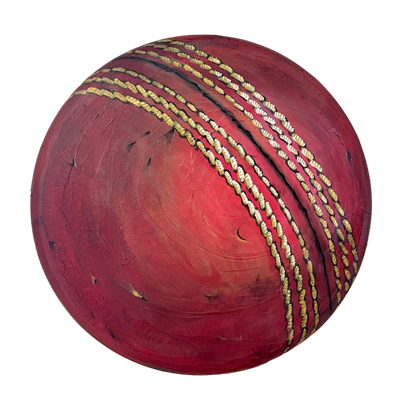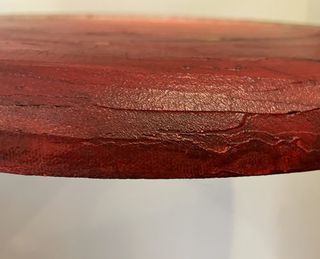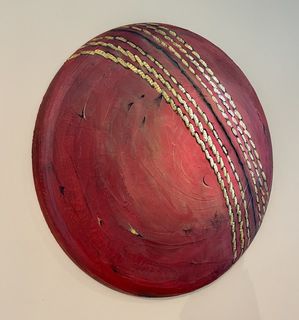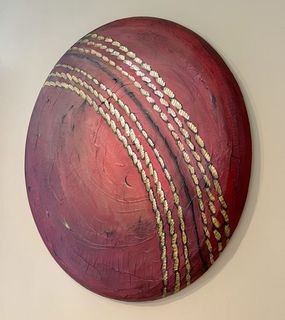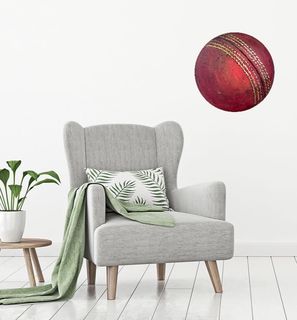The Winners Ball - Cricket Ball Painting
"The Winner's Ball" A Cricket Connoisseur's Conversation Piece
Introducing "The Winner's Ball", a captivating, 3D-look round artwork that outshines a standard cricket ball painting. This mixed-media exploration by New Zealand contemporary artist Collette fergus, where art and cricket collide, is rendered in meticulous detail on a unique, convex canvas. The intricate stitching and mesmerising crackle effect evoke a well-worn, vintage ball, making it a truly unique piece in any collection.
And its more than just memorabilia; "The Winner's Ball" invites contemplation. The textured surface and careful craftsmanship spark conversation, making it a focal point for any discerning collector or cricket enthusiast.
For the Strategist: Every brushstroke whispers of legendary matches, a silent dialogue between artist and viewer. This is a piece that celebrates not just the game but its enduring legacy.
And it isn't just about blind passion; it is about appreciating the artistry behind cricket history. "The Winner's Ball" offers you the unique and exciting opportunity to own a piece of history, giving you a talking point for guests and elevating your space with a timeless design and a touch of vintage allure.
Details:
- Signed, one-of-a-kind artwork by Collette
- 508mm wide x 25mm deep convex canvas
- Crafted with quality artists' brand Golden acrylics, gels, and mediums
Cricket aficionados, this is your chance to showcase your love for the game in a truly unique way. Contact Collette today.
Price: NZD $780.00
What do we Know About Cricket Balls?
Cricket balls are made from a combination of cork, string, and leather. The cork serves as the ball's core, covered in tightly wound string, and then finally covered in leather, giving it its distinctive appearance and texture. The leather used to cover the cricket balls is traditionally cowhide, although some are now made from synthetic materials.
The type of leather used in the ball is carefully chosen for its strength, durability, and ability to provide a good grip on the pitch. This is especially important for the ball's seams, which play a critical role in the ball's performance.
The stitching on a cricket ball is crucial to its performance, creating a raised seam on the ball, which helps to grip the pitch and create movement in the air or off the pitch. The seam of the cricket ball can also be used by bowlers to create spin. By rotating the ball in their hand as they bowl, a bowler can make the ball spin in either direction.
Cricket balls come in two main types: red and white. Red balls are used in Test cricket, the longest and most prestigious form of the game. White balls, on the other hand, are used in limited-overs cricket, such as One Day Internationals and T20 matches.
Did you know the red colour of Test cricket balls which is due to the red dye used to colour the leather, makes it more visible on the green grass of the cricket pitch. White balls used in limited-overs cricket are also made from cork, string, and leather they are painted white to make them more visible against coloured clothing and in floodlit conditions.
The weight and size of a cricket ball are regulated by the International Cricket Council (ICC) to ensure consistency across all matches. The ball typically weighs between 5.5 and 5.75 ounces and has a circumference of between 8.81 and 9 inches.
While cricket balls can be expensive, with high-quality balls costing hundreds of dollars, their cost is justified by the manufacturing process's labour-intensive nature and the high level of skill required to make them.
Additionally, cricket balls can be dangerous, especially when bowled at high speeds. Batsmen wear protective equipment to guard against injuries from the ball, but injuries can still occur. A cricket ball can reach speeds of up to 90 miles per hour, which makes it a potentially lethal weapon in the hands of a skilled bowler. So if you were wondering why cricketers wear protective gear, now you know!
At the End of the Day
every aspect of a cricket ball is carefully considered to ensure it performs at the highest level. The construction, colour, size, weight, and stitching of the ball all play an essential role in the sport of cricket, making it one of the most important components of the game.
Interested in owning this unique painting? Contact Collette now for more information.
